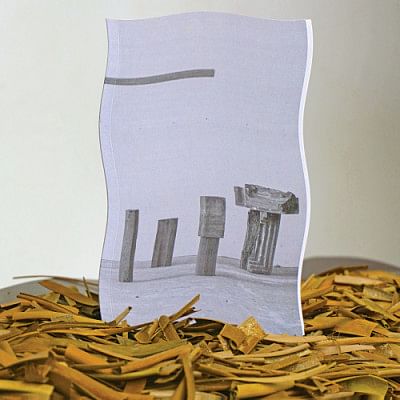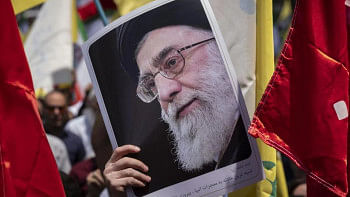Nabil Rahman yearns for big truths with few words in ‘Water Bodies’

About this book, I'd like to speak simply. Because Nabil Rahman's Water Bodies (Nokta/ Boobook, 2020) speaks simply too, without frills or embellishment. It holds space by offering it to the reader in the form of blank pages between its poems, much like the spaces that remain amidst Rahman's sculptures on the book's cover image.
I wouldn't call Water Bodies a book of poetry. Written with few words, it is an extension of his artistic practice, and accompanies his ongoing solo exhibition of the same name at Studio 6/6 in Mohammadpur. Rahman, who is an old, soft-spoken and restless friend of mine, tells me that the book and the show are two different bodies of work but nevertheless in conversation with each other. The book holds his poems and photographs of his sculptures and performances, and I'm of the sincere opinion that audiences can engage with this book better if they have visited the show.
His exhibition puts forward an oeuvre of visual works that meditate over symmetrical grids, lines, and shapes in search for a "code of life", all the while breaking out of these patterns just when I'm not looking. He engages with geometry and demarcations while reflecting upon his own existence and memories rooted in urban landscapes. I can read similar reflections in his book where his very first poem begins with a panic and a caution: we will become the very machines we have created.
I like to read his book in parts. The first chapter, for me, is a collection of poems and sculptures that evoke yearning and false nostalgia for a world he hasn't had access to as a brown man in the West. His poems complain about corn syrup and helicopters, imposterism and pretence, and internal conflicts.
But then a series of photographs (from his 2017 residency at the Philippines-based non-profit Bellas Artes Projects) documents Rahman's slow acknowledgement of a bed of nails, upon which he lays to rest carefully. And this marks the next chapter of poems for me, where the poet "rose like the phoenix" from his worldly disputes and is now healing "the burnt skin under their flaming wings" with a series of verses that read like small lessons of truth. They read a little preachy to me, but they are also accompanied by sculptures that are carved inwards to create hollow vessels. I cannot help but notice the irony of empty vessels set against verses that complain about humankind's habit of hoarding and overproducing. Somewhere here, one can sense Rahman's politics, which can ironically read like a lack of politics too, because of how simple and easy his poems read. But here is some scepticism about science and modernity, some commentary about human nature, and some reflections on the vastness of time and being forgotten.
A photograph of Rahman holding a crooked tree branch cues the next and final part of the book for me. He recovers from the sermons and empty vessels he relied upon previously. Now, he starts speaking clearly, with abundant faith and without any regard for the rules of language or poetic style. His sculptures are now quadrilateral, sharp-edged; the ridges and grooves on them are uniform and certain. But the poet himself is now on a "search for roots", so his words move in all directions much like roots grow in the soil for water. In these poems, there are no set truths in the absurdity of his dreams and feelings, but simply the need to keep moving in ways only poetry can beyond borders and syntax.
It is a little annoying that there are no page numbers or titles, and therefore no way for a reader to refer to a poem except by what they remember and hold from it. Rahman almost nudges you to talk back because now you have to speak your mind about what you have read if you want to speak about it at all. So he leaves a few blank pages for the reader at the end. He is not too worried about marking territories with a book; after all, he is the kind of poet that would rather "always be leaving".
maliha mohsin is a writer, researcher, and community organiser, with a focus on the intersections of art and queer-feminist politics.

 For all latest news, follow The Daily Star's Google News channel.
For all latest news, follow The Daily Star's Google News channel. 



Comments